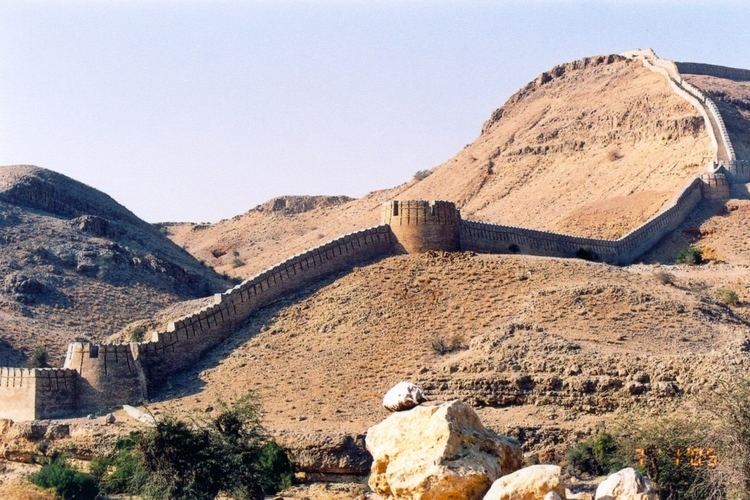Type Fortification Founded refurbished in 1812 Phone +92 345 5220488 | Material Stone and lime mortar Length 31,000 m | |
 | ||
Builder Refurbished by Mir Karam Ali Khan Talpur and Mir Murad Ali Similar Chaukhandi tombs, Kirthar Mountains, Kot Diji Fort, Rohtas Fort, Faiz Mahal | ||
Ranikot fort
Ranikot Fort (Sindhi: رني ڪوٽ, Urdu: قلعہ رانی کوٹ Hindi: रानीकोट क़िला) is a historical fort near Sann, Jamshoro District, Sindh, Pakistan. Ranikot Fort is also known as The Great Wall of Sindh سنڌ جي عظيم ديوار and is believed to be among one of the world's largest forts with a circumference of approximately 26 kilometres (16 mi). Kumbhalgarh Fort, a World Heritage Site as part of the Hill Forts of Rajasthan, with over 38 km long wall has the second longest wall in the world after the Great Wall of China. The fort has been compared to the Great Wall of China. Since 1993, nominated by the Pakistan National Commission for UNESCO, Ministry of Education under the cultural criteria, it has been on the tentative list of UNESCO World Heritage Sites. The fort is listed as a historical site under the Antiquities Act, 1975 and its subsequent amendments and is provided protection.
Contents
Ranikot fort sindh pakistan
Location
Ranikot Fort is 90 kilometres (56 mi) to the north of Hyderabad on the national highway. There is also an easy access of about an hour's journey from Karachi to Sann on the Indus Highway. A diversion road, starting a little distance away from Sann, the nearest town, leads to the fort along a rugged 21 kilometres (13 mi) road and reaches the eastern gate of the fort, known as Sann Gate. Sann is a rail head on the Kotri-Larkana line of the Pakistan Railway. It is inside the Kirthar National Park, the second largest national park in Pakistan.
History
The original purpose and architects of Ranikot Fort are unknown. However, it is believed that the fort was built during the regimes of the Sassanians, the Scythians, the Parthians or the Bactrian Greeks. Archaeologists point to the 17th century as the time of its first construction but Sindh archaeologists now agree that some of the present structures were reconstructed by Talpurs in 1812 at a cost of 1.2 million rupees (Sindh Gazetteer, 677). The battlements of Ranikot formed the last capital of the Amirs of Sind, when they were brought under the colonial rule of the British Empire. Radiocarbon tests were conducted at the Sann Gate on the charcoal embedded in the mortar of a collapsed pillar of the eastern gate of the fort. These tests have confirmed that this gate was probably renovated between the early part of the 18th century and the early part of the 19th century, prior to Britain invading the fort when the Kalhoras, or most likely the Talpur Mirs of Sindh ruled over the area.
Features
The fort is huge, connecting several bleak mountains of the Kirthar hills along contours, and measures 31 kilometres (19 mi) in length. The fort is interspersed with several bastions in between and three are of semi-circular shape. The northern part of the fort's perimeter is a natural high hilly formation while on the other three sides it is covered by fort walls. Within this main fort there is a smaller fort known as the "Meeri" which is about 5–6 miles from the entry gate of the main fort, and is reported to have served as the palace of the Mir royal family. The entire fort structure has been built with stone and lime mortar. The fort is built in a zig-zag form, with four entry gates in the shape of a rhomboid. Two of the gates, facing each are crossed diagonally by the Sann river; the first gate is on the western side and is skirted by the river water and is difficult to approach. The southern entry gate has a double doors gate. Within the gates there are two niches which have floral ornamentation and carved stones. The Sann gate is well preserved and can be climbed to reach the top of the fort from both sides to get a scenic view of the terrain around the fort. This gate is also the entrance to the Meeri.
Restoration
Restoration works were undertaken on the fort, particularly on the Sann Gate complex, the fortification wall extending south including the mosque and the small Meeri fort or palace within the main fort. These were undertaken by the Archaeology department of Pakistan, the Department of Culture of Sindh and the Dadu district administration. Following allegations of poor construction and favoritism in award of contracts an enquiry was instituted in 2005. The Enquiry Commission's report indicated that the restoration works were poorly done with cement and new stone work without conforming to the "Venice Charter for the Conservation and Restoration of Monuments and Sites" and recommended stoppage of further work on the fort. Based on this report further restoration work was suspended in 2006.
